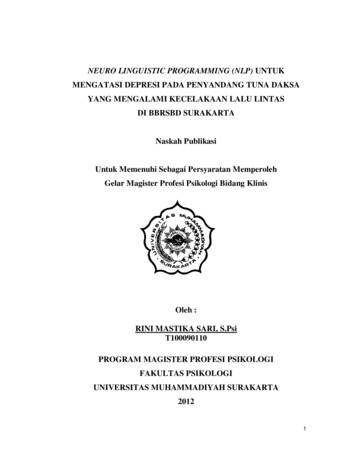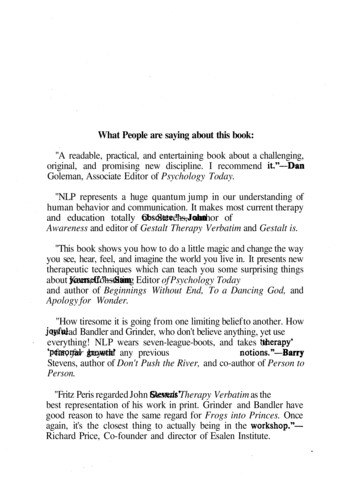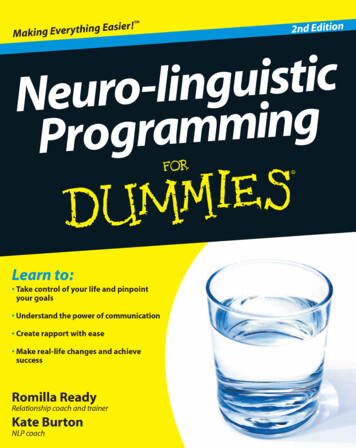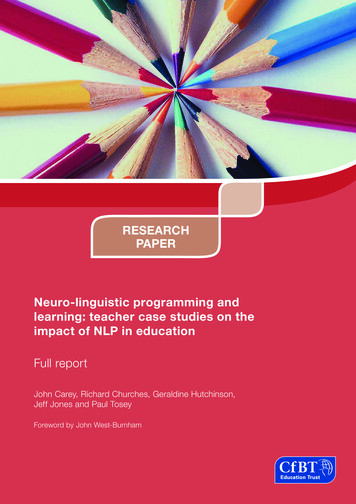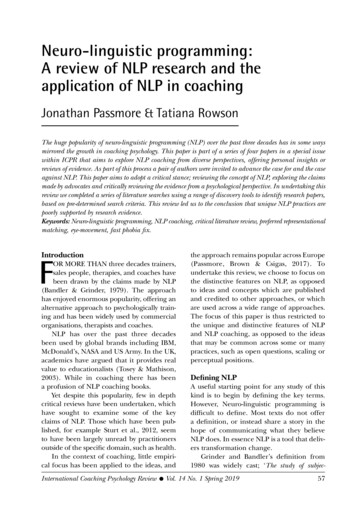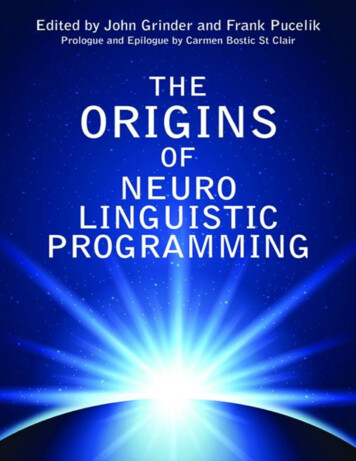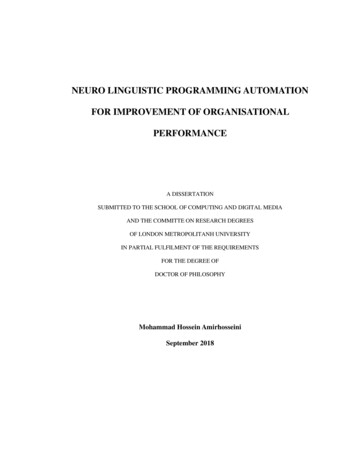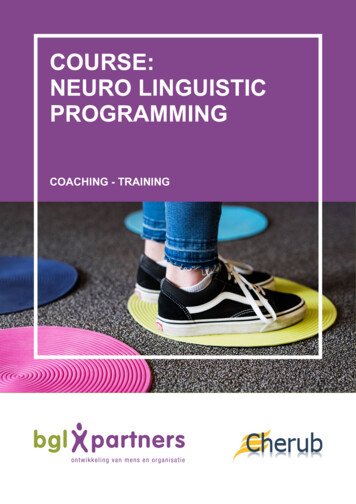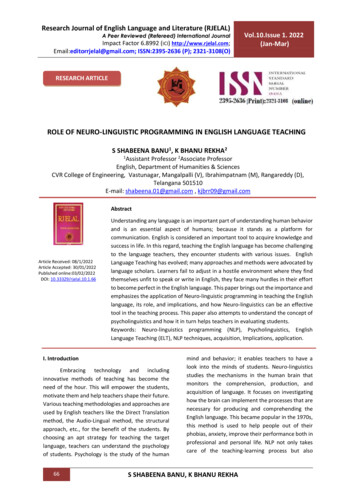
Transcription
Research Journal of English Language and Literature (RJELAL)A Peer Reviewed (Refereed) International JournalImpact Factor 6.8992 (ICI) http://www.rjelal.com;Vol.10.Issue 1. 2022(Jan-Mar)Email:editorrjelal@gmail.com; ISSN:2395-2636 (P); 2321-3108(O)RESEARCH ARTICLEROLE OF NEURO-LINGUISTIC PROGRAMMING IN ENGLISH LANGUAGE TEACHINGS SHABEENA BANU1, K BHANU REKHA21Assistant Professor 2Associate ProfessorEnglish, Department of Humanities & SciencesCVR College of Engineering, Vastunagar, Mangalpalli (V), Ibrahimpatnam (M), Rangareddy (D),Telangana 501510E-mail: shabeena.01@gmail.com , kjbrr09@gmail.comAbstractArticle Received: 08/1/2022Article Accepted: 30/01/2022Published online:03/02/2022DOI: 10.33329/rjelal.10.1.66Understanding any language is an important part of understanding human behaviorand is an essential aspect of humans; because it stands as a platform forcommunication. English is considered an important tool to acquire knowledge andsuccess in life. In this regard, teaching the English language has become challengingto the language teachers, they encounter students with various issues. EnglishLanguage Teaching has evolved; many approaches and methods were advocated bylanguage scholars. Learners fail to adjust in a hostile environment where they findthemselves unfit to speak or write in English, they face many hurdles in their effortto become perfect in the English language. This paper brings out the importance andemphasizes the application of Neuro-linguistic programming in teaching the Englishlanguage, its role, and implications, and how Neuro-linguistics can be an effectivetool in the teaching process. This paper also attempts to understand the concept ofpsycholinguistics and how it in turn helps teachers in evaluating students.Keywords: Neuro-linguistics programming (NLP), Psycholinguistics, EnglishLanguage Teaching (ELT), NLP techniques, acquisition, Implications, application.I. IntroductionEmbracing technology and includinginnovative methods of teaching has become theneed of the hour. This will empower the students,motivate them and help teachers shape their future.Various teaching methodologies and approaches areused by English teachers like the Direct Translationmethod, the Audio-Lingual method, the structuralapproach, etc., for the benefit of the students. Bychoosing an apt strategy for teaching the targetlanguage, teachers can understand the psychologyof students. Psychology is the study of the human66mind and behavior; it enables teachers to have alook into the minds of students. Neuro-linguisticsstudies the mechanisms in the human brain thatmonitors the comprehension, production, andacquisition of language. It focuses on investigatinghow the brain can implement the processes that arenecessary for producing and comprehending theEnglish language. This became popular in the 1970s,this method is used to help people out of theirphobias, anxiety, improve their performance both inprofessional and personal life. NLP not only takescare of the teaching-learning process but alsoS SHABEENA BANU, K BHANU REKHA
Research Journal of English Language and Literature (RJELAL)A Peer Reviewed (Refereed) International JournalImpact Factor 6.8992 (ICI) http://www.rjelal.com;Vol.10.Issue 1. 2022(Jan-Mar)Email:editorrjelal@gmail.com; ISSN:2395-2636 (P); 2321-3108(O)enhances linguistic competence, communicativecompetence, decision making, and self-esteemeffectively.II. MethodologyUnderstanding Neuro-linguistic ProgrammingNeuro-linguistics has its roots entwined withvarious fields such as neuroscience, linguistics,cognitive science, communication disorder, etc. Theterm NLP can be explained in the following manner:Neuro (an emotional component- how our state ofmind affects the body), linguistics (language- ourstate of mind is revealed by verbal and non-verbalcommunication), Program (perception) it tells ushow language is represented in the brain. NLPdetects the hurdles and fears of the language learnerand eliminates them. NLP involves variousstrategies, it relates thoughts, emotions, andbehavioral patterns of students. We need both intraand interpersonal skills to lead a successful life,which means, NLP focuses not only on how youcommunicate with others but also on how youcommunicate with yourself. It is a much-neededskill, it can change your thought process, helpanalyze past events, and understand your approachto life.Neuro-Linguistic Programming wasdeveloped in the 1970s by John Grinder, a linguist,and Richard Bandler, scientist and mathematician.In their first book on NLP, Structure of Magic: A bookabout Language of Therapy, certain aspects werehighlighted, how some communicators do wellcompared to others. The biggest question was whatmade the therapists such as Virginia Satir, RobertDilts, and Milton Erickson so special, what exactly isthe difference between an average and exceptionallearning behavior. NLP is a powerful full andeffective method to quickly obtain an understandingof the motives and motivations of our actions.Brain stores information in brain cells, it is likea network and this network controls our movement,internal and external sensations. For example,speech, sight, sound, feel, etc. The brain processesthe information parallelly, every time the brain triesto access the information, the network may getstrong or weak. New networks or connections areformed when a specific skill or language is learned.We cannot guarantee that the raw material or basic67knowledge of the language is stored in a certain cellof the brain, the information that comes togetherwhen we understand or say a word arrives frommany cells of the brain. For example: when we saythe word ‘apple’, our brain recalls the pre-storedinformation about the apple, how does it look? howdoes it taste? How does it smell? BY this, we can say,that activities like listening, speaking, reading andwriting need the involvement of the information inthe brain cells.The four pillars of NLPThe techniques and strategies of NLP empower theteaching-learning process by making it effective andgoal-oriented. By using suitable approaches andtechniques of NLP, the English language teacherscould work on language acquisition, self-esteem,self-confidence, body language, therapy, personalitydevelopment, etc. This kind of environment isconsidered to be motivating and helpful toovercome any issues or problems faced by studentsin learning the target language. NLP helps inassessing the multi-dimensional process of thehuman mind, it studies the cognitive and mentalability of humans. The interaction between the bodyand mind of the students is closely monitored by theteacher, consistent patterns are identified, gaps arefilled and specific goals are achieved. This approachwill give an insight into the learner’s mind andthought process by analyzing the kind of languageused by students. It aims to achieve the desiredresult by altering the thought process and action ofthe learner. According to Gracia and Tamayo,Language learners can use NLP as apsychotherapeutic technique to improve theperformance of students and take a step towardsachievement. It is necessary to understand thatpsychological factors play a prominent role inbuilding confidence, dealing with anxiety andhesitation, etc. They also leave a strong impact onattitude, aptitude, personality, and languagelearning.Four pillars of NLP:1.Outcome orientation2.Sensory acuity3.Behavior flexibilityS SHABEENA BANU, K BHANU REKHA
Research Journal of English Language and Literature (RJELAL)A Peer Reviewed (Refereed) International JournalImpact Factor 6.8992 (ICI) http://www.rjelal.com;Vol.10.Issue 1. 2022(Jan-Mar)Email:editorrjelal@gmail.com; ISSN:2395-2636 (P); 2321-3108(O)4.RapportOutcome orientation: Outcome orientation is anoutcome-oriented discipline, and defining theoutcome is imperative. This might sound harebrained; eighty percent of the students do not haveclarity about their goals. Often students fail tounderstand what it is that they truly desire in life andtherefore they drift from one thing to another. It isnatural to be drawn towards negativity, havingdoubts, or second thoughts about the targets.Outcome orientation sets the direction for thestudents by making them choose a positive path, acrystal-clear outcome will lead the students in thestrategically designed plan.Sensory acuity: In this, we use our senses tounderstand and have awareness of the path weare walking on to get the desired outcome.Having the knowledge of what works for you isnot enough, one must also have an ability toanalyze and distinguish between what worksand what does not. Many a time, students areseen repeating the procedure, this pillar tellsthem to identify the mistakes and change thestrategy. Students must learn to register theminute details around them. Some students arealways alert and observant and some arecareless by choice. This pillar reduces the gapbetween students and /her goal hence, it isconsidered an extremely important pillar in NLP.This helps students to communicate effectively,work on soft skills, non-verbal communication,etc.The practice of NLP can be strengthened by theRepresentational systems. The representationalsystems are referred to as VAKOG (V- visual, Aauditory, K- kinesthetic, O-olfactory, Ggustatory)Behavior flexibility: Flexibility can be defined asthinking of multiple ways to complete a certaintask and being confident with the success rate.One must understand the concept of tryingalternatives and switching the approaches tocomplete a task. Students must learn to adaptthemselves to any situation, keeping all theoptions open will increase the chances ofsuccess.68Rapport: This is something that helps learnersunderstand each other’s feelings or ideas andcommunicate comfortably. It is a skill that isinbuilt and happens naturally but, it needs to beenhanced once in a while. It shapesrelationships with mutual trust andresponsiveness, it maximizes the similaritiesand minimizes the differences betweenindividuals. Students must have the capability toget along, agree with patterns, acceptdisagreements and build a good rapport withfellow students.NLP in the classroomNLP is considered an effective tool to enhance thestudent’s education, professional life, and personallife. NLP can be applied as a supplementarytechnique to improve effectiveness in the teachinglearning process. As teachers, the main agenda inthe process must be to change the behavior ofstudents towards language learning. The techniquesof NLP help students overcome significant blocksthat might otherwise hold them back. It won’t bewrong to state that NLP also plays a vital role ininculcating life skills, empowering students, therapy,psychoanalysis, influence skills, helping fightdepression and addiction, etc. The techniquesmentioned are not so popular among practitionersbut, the results are outstanding. These techniquesmentioned below were applied and tested in theEnglish language classroom and the results wererecorded meticulously.1.State InterruptFor a better understanding of this technique, onemust know what exactly state means, a state hereis like a loop, where students are stuck in a patternof behavior. This technique reinforces the patternand encourages the person to go deeper into thestate, identifying the problem and compellingthem to re-live, re-think and re-experience thesituation. In this way, pattern interrupt breaks theconnection and helps to stop runaway state,resolve conflicts, de-escalate tension.2.Spinning FeelingsThis technique recognizes that feelings do not juststop and go dormant, they must on. Humans areS SHABEENA BANU, K BHANU REKHA
Research Journal of English Language and Literature (RJELAL)A Peer Reviewed (Refereed) International JournalImpact Factor 6.8992 (ICI) http://www.rjelal.com;Vol.10.Issue 1. 2022(Jan-Mar)Email:editorrjelal@gmail.com; ISSN:2395-2636 (P); 2321-3108(O)emotional beings and if we recognize the pointwhere we feel something, we can change it.Feeling a certain emotion in our body will help ususe our imagination to move it or push it away andchange it in any number of ways. Students oftenoutside their awareness do the activity ofgenerating frustration, anger, happiness, etc. Themore they repeat it the better their body becomesat concentrating and maintaining the feelings.3.Collapsing AnchorCollapsing anchoring falls under the category ofAnchoring. In anchoring two feelings or emotionsare linked together neurologically. By practicingcollapsing anchoring, Issues can be dealt with;problems can be solved or it can trigger goodfeelings when they meet. Let’s just say, students inan English language classroom face two oppositeemotions like fear and joy. The body experiencesthe two at the same time, it forces the student’smind to recognize itself, to a positive state. This iscalled collapsing anchoring.4.TimelinesIt is a powerful technique to let go of emotionalpain without any drama, it is like replacing our oldstory or trauma with a new one or reliefrespectively for a successful full, and happy life.We regret our past actions or how we reacted tocertain situations and promise ourselves not torepeat them in the future. This technique worksefficiently, releases past negative experiences, andchanges an inappropriate program. It is observedthat students let negative emotions weigh on theirminds.5.Mind Reading patternIn this pattern, our mind plays a prominent role.Mind reading is when you assume that you knowwhat another person thinks or feels in a givensituation. It is like our mind picks up the hintsdropped by a person, via body language, facialexpressions, etc. We can say this as jumping toconclusions and judging others. It is best to stick toreality, verified emotions, and assured experiencesrather than accumulating hints.696.SwishThis technique works on an individual’s senses, itchanges how a person thinks, feels, and acts.Students are made to imagine a positive, bright,and happy situation further they are asked tochoose an emotion or thing they would like toreplace. Playing with positive and negative feelingsand prioritizing by segregating what a personwants and what must be deleted is the style of thistechnique. In an English classroom, students areasked to imagine the negative feeling as big aspossible and let the positive feeling fade away byshrinking it, making it dull and dim. This process isrepeated three to four times and finally, studentsare asked to bring in the positive feeling at once asa big bright image leaving no place for negativefeeling in mind. i.e., Reprogramming one’s mindfrom unwanted behavior to the desired behavior.7.DissociativeThe dissociative technique sets free all theoverwhelming emotions. Students must identifyan emotion they want to get rid of and feel it floatoff their bodies. In other words, we can call thisone of the many elements of meditation,breathing in and breathing out makes our tensionsgo away and helps us focus on important things.8.CalibrationThe calibration technique works best for thosewho know good body language knowledge andpossess analytical skills. It helps students noticethe obvious and get an insight into anotherperson’s mind. Acquiring this skill makes studentswell-equipped to face any questions or tasks underany circumstances, this helps not only in answeringthe questions but also in preparing the appropriatequestions. This enables a person to see better,listen better, understand better by payingattention and monitoring the body language ofothers.III. Data and Findings- ResultNLP techniques fetch desired results whenapplied properly in a classroom. The issues faced byS SHABEENA BANU, K BHANU REKHA
Research Journal of English Language and Literature (RJELAL)Vol.10.Issue 1. 2022(Jan-Mar)A Peer Reviewed (Refereed) International JournalImpact Factor 6.8992 (ICI) ; ISSN:2395-2636 (P); 2321-3108(O)students are not known to the teachers, studentsnever reveal them. Despite repeated failures,students barely try to improve themselves. But thecareful application of various NLP techniques in theclassroom shows a drastic improvement in theattitudes of students. The charts below show thedetails of some techniques applied in the classroomand the outcome of these techniques.1.The very first activity in any class, for thestudents is an introductory session.Students are asked to introducethemselves, talk about their likes, dislikes,hobbies, fears, strengths, and weaknesses.And, this is where seventy-five percent ofthe students fail to introduce themselves,they don’t even come forward to do it.Swish technique helps in these situations.Students are made to focus on all thenegative things stopping them again andagain till they get the positive image brightand clear by leaving no space for any fears,anxieties, etc.LSRW Skills- Second Year students40%30%20%10%0%Listening Speaking Reading WritingBerforeSimultaneously, the below-mentioned problemscan be monitored.Second Year students40%20%0%hesitant studentslack offailedintererstat stress managementfear of failureBefore3.As shown below, the data is collected in thefirst-year English language lab of 60 students.First Year studnets60%40%20%0%CofidentspeakersLack offluencyBefore2.FearNo basicsAfterA class of sixty are given variousassignments which cover all the four skills(listening, speaking, reading, writing), atthe beginning of the semester. Stateinterrupt pattern was applied for twomonths and the results were positive.AfterBook review in an activity that focuses ontwo skills at a time, reading and speaking.Third-year students are assigned books wellin advance and at the end of the semester,students give reviews of the books.Students were asked to give a review of anybook, any short story, or the review of anyarticle they have read in the past. This willhelp teachers to assess their skills and notethe improvement later. Collapsing anchortechnique is applied and the result is can beseen below.Book Review- Third Year terwritingThis activity builds confidence in thespeakers, which they need as they will beS SHABEENA BANU, K BHANU REKHA
Research Journal of English Language and Literature (RJELAL)A Peer Reviewed (Refereed) International JournalImpact Factor 6.8992 (ICI) http://www.rjelal.com;Vol.10.Issue 1. 2022(Jan-Mar)Email:editorrjelal@gmail.com; ISSN:2395-2636 (P); 2321-3108(O)steeping out of college and they need lifeskills to survive. The feeling of anxiety,stage fright must be taken care of, thetechnique of dissociation is applied to aclass of sixty students from the fourth year.Public Speaking- Fourth Yearstudents100807.NLP techniques are time-consuming andmay seem redundant to the students.8.Teachers have to take care of personalityclashes in the classroom.9.Cultural diversity10. The process of selecting, evaluating,assessing, and recording progress is atedious process.Students might face the following challenges:60401.Students see the teachers as a threat, whowill expose their limitations.2.Fear of being judged by their classmates.3.Unable to balance the workload and copewith the changes in the classroom.4.Studentsmightgetunmotivated, and findunproductive.5.No clarity on the technique being used andthe outcome.6.Focusing on one or two skills at a timemakes few students lose interest in theactivity.200Semester-1Semester-2ChallengesThe biggest challenge faced by teachers inEnglish language classrooms is not being able todecide the suitable method and appropriateapproach to teach. As mentioned earlier, studentshave different attitudes and come from differentbackgrounds. So, for a teacher to be effective it isimportant to get updated with the latest technologyand techniques of NLP and inculcate them into thepedagogy. By using the technology, the importanceof teachers will be reduced is a commonmisconception rather it makes teaching moreefficient and effective. The linguists have come upwith so many techniques but only a few techniquescan be practiced in the classroom. NLP techniquesare learner-centered rather than teacher-centered.Some challenges that teachers might face are listedbelow:bored,leftthe processNLP techniques are game-changers they workon the limitations of the students with the helpof various NLP techniques is a real challenge tothe teachers. The implications of NLP onteachers and students are almost the same,these techniques work only when both teacherand student take equal responsibility.1.Reluctance of studentsIV. Conclusion2.No knowledge about the application of thetechnique.3.Difficult in managing the time.4.Shift from traditional teaching to new couldbe difficult5.Infrastructure6.Enduring attention may not be possible.NLP plays a significant role in the life ofstudents; it teaches them to build themselves strongenough to face take up any challenge. Without adoubt, these techniques help students with thetarget language but they also gain confidence, selfresilience, which works on self-esteem. These willbring a tremendous change in their attitudestowards life, they turn out to be psychologicallystrong which is exactly how NLP works. This paperdeals with various techniques of NLP and what71S SHABEENA BANU, K BHANU REKHA
Research Journal of English Language and Literature (RJELAL)A Peer Reviewed (Refereed) International JournalImpact Factor 6.8992 (ICI) ; ISSN:2395-2636 (P); 2321-3108(O)happens when these techniques are practiced in anEnglish language classroom. Language acquisitionbecomes easy when these techniques are applied.ReferencesDelbio,A., & Hankumaran, M. (2018). SecondLanguage Acquisition through Neurolinguistic Programming: A eering & Technology, 7(4.36), 624-629.Edge, J. Essentials of English language teaching. NewYork: Pearson Education, Longman (1993)Bandler R & Grinder J, Neuro-LinguisticsProgramming, Real People Press, (1979).Naim, M. Soft Skill Development: Relevance ofNeuro-LinguisticProgramming(NLP).Language in India, press (1981)O’Connor J & Me Dermott I, Principles of NLP,Vintage Publishers, (1996).Pishagham R, “Neuro-linguistic Programming (NLP)for Language Teachers: Revalidation of anNLP scale”, Theory and Practice in LanguageStudies. Vol.16, No.44, (2015).Revell J & Norman S, In Your Hands: NLP in ELT.Saffire Press, London, (1997).Vinothees AP, “Importance of Accuracy inDevelopingEnglishSpeakingSkills”,International Journal of English Language andLiterature in Humanities (IJELLH) IF 5.7, Vol.6,No.4, (2018), pp. 143-151.Winch, S. “From Frustration to Satisfaction: UsingNLP to improve self-expression. EducationConference. Vol.1872S SHABEENA BANU, K BHANU REKHAVol.10.Issue 1. 2022(Jan-Mar)
Understanding Neuro-linguistic Programming Neuro-linguistics has its roots entwined with various fields such as neuroscience, linguistics, cognitive science, communication disorder, etc. The term NLP can be explained in the following manner: Neuro (an emotional component- how our state of mind affects the body), linguistics (language- our .
